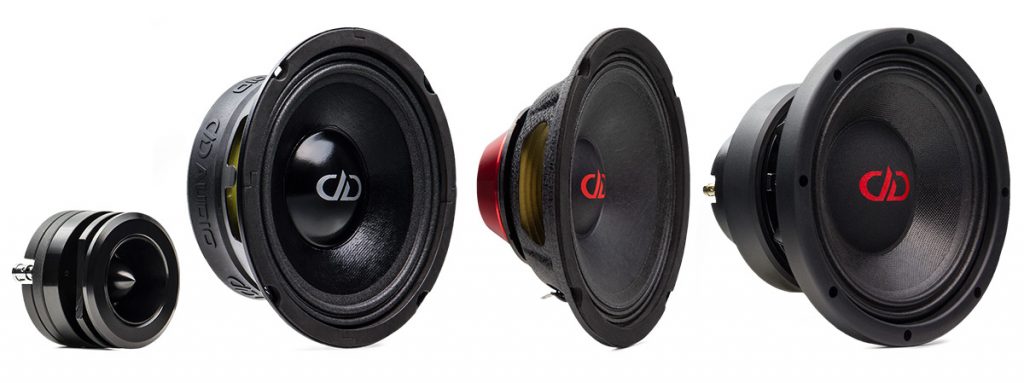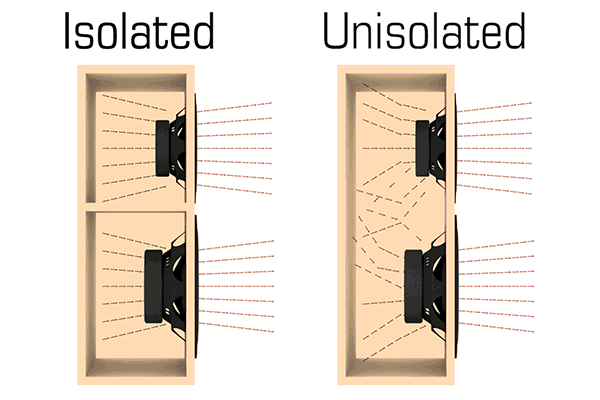
Tech Talk: PA Practicality – Part One
If you’ve got loud pipes on your bike but you still wanna jam, what’s the move? If you’ve got a huge subwoofer system in your car and it’s drowning out your door speakers, what’s the move? If you’re out thrashing the dunes in your Side by Side and you want the music as loud as that little rapped-out turbocharged motor under the hood, what’s the move? Well, “the move” my friend, is Pro Audio. Pro Audio (PA) drivers, as they’re ubiquitously called in mobile electronics, are extremely efficient, high output speakers. Today we’ll take a look at how to set-up a fully active network of 3-way PA speakers and some of the design considerations necessary, like sealed chambers and IB-style alignments, to help maximize the sound quality and performance.
Those of you that have read the April 2019 Tech Talk: The Perfect PA Punishment – A Guide to Melting Your Face Off Through The Magic of Sound, will remember that we talked about The Perfect PA Punishment being comprised of 3 things.
- VO-B Tweeters
- VO-M and VO-MN Mid-Range Drivers
- VO-W Mid-Bass Drivers
In order to make sure we get the most out of these speakers, we’ll want to insure two things. One, that no driver type plays into a chamber with the other driver type, and two, that no driver type is playing in a frequency range that another driver type is playing into.
Why don’t we want different drivers playing in the same space as other drivers?
Most home speakers function off this principal. The reason for this is that speakers make sound waves as they emanate outwards from the woofer, and they also make another sound inward when the driver moves backwards. These inner waves can interfere with other drivers, especially when we’re using a big beefy mid-bass driver like a VO-W and we make it play against something more delicate, like a VO-M. The VO-W driver is strong enough to create pressure on the back of the smaller VO-M that can cause it to move sympathetically and cause lots of distortion.

Now, if you have room to build an enclosure for a large driver like a VO-W10 or VO-W15, by all means, have at it! However the easier choice is to isolate the mid-range drivers from the rest of the speakers. The enclosure is much more manageable to construct. Additionally, having the VO-W’s playing open into the door more closely simulates an infinite baffle alignment where the driver can be crossed over much lower, albeit at the cost of some mechanical power handling. Luckily, most tweeters, including VO-B and VO-CT tweeters, are sealed back drivers and they don’t need any enclosure at all. You can pretty much stick them anywhere they’ll fit.
Isolating your door drivers can go a long way to providing them with more longevity, less distortion, and greater output. Remember both VO-W mid-bass drivers and VO-M/MN mid-range drivers can benefit from being in their own enclosures. However, if you only have room for one, make sure it’s the mid-range.
Once the door has been built up and the speakers have been installed into their respective spaces (sealed or otherwise) we can set our crossovers. Crossovers are actually the simplest part of this if you’ve done your homework and have at least one channel of amplification for each speaker type. So here’s how we’ll want to break down the High-Pass Filters (HPF) and Low-Pass Filters (LPF).
Tweeters –
- HPF – 2x Fs (2x low frequency range on DD Audio Website)
Mid-Range –
- HPF – System Resonance of our mid-range enclosures
- LPF – Same frequency as Tweeter HPF
Mid-Bass –
- HPF – Free Air Resonance (Fs) of driver if IB or System Resonance of mid-bass enclosure
- LPF – Same Frequency as Mid-Range HPF
From here you’ll want to set the gains on your amp/s, apply delay if you’re using time alignment, and begin the EQ-ing process to achieve your own audio nirvana. These aspects are outside the scope of this article, but you can be assured that we’ll address it at some point in the future. We do however want to address a couple loose ends with enclosure design for your door build outs and we will do exactly that in Part Two. In the meantime if you have any questions about the information presented here, or any other audio related topic, be sure to give DD Audio Tech Support a call and we’ll be happy to help you out.
Check Out The New Tech Talk YouTube Series
